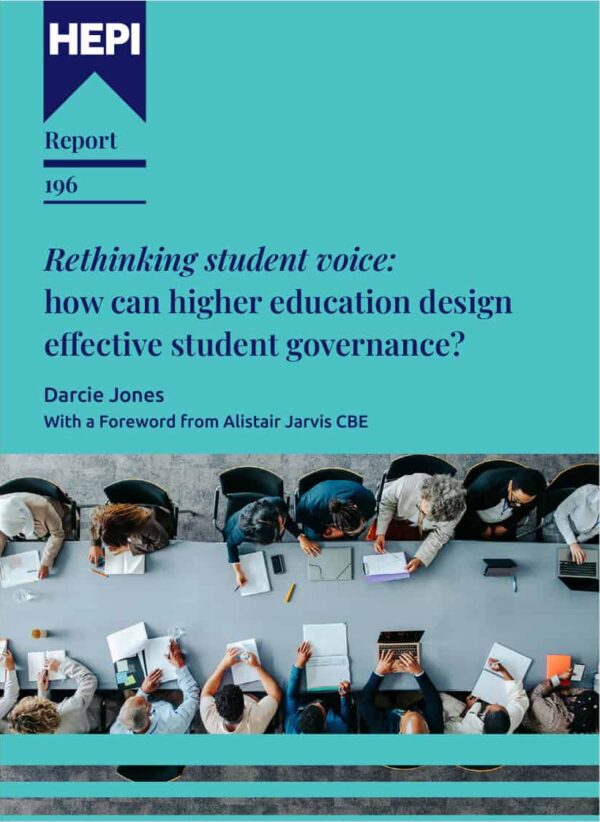Teaching students how to talk: why dialogue belongs at the heart of higher education
UK universities are under mounting financial pressure. Join HEPI and King’s College London Policy Institute on 11 November 2025 at 1pm for a webinar on how universities balance relatively stable but underfunded income streams against higher-margin but volatile sources. Register now. We look forward to seeing you there.
This blog was kindly authored by Estefania Gamarra, Postdoctoral Research Fellow, and Marion Heron Associate Professor in Educational Linguistics, both from the University of Surrey Institute of Education. It was also authored by Harriet R. Tenenbaum Professor in Developmental and Social Psychology and Lewis Baker Senior Lecturer in Chemical and Process Engineering – Foundation Year, both from the University of Surrey.
Today’s higher education sector faces a need to increase student progression and improve retention. This goal is especially necessary for Foundation Year programmes. A proposed solution is active learning. Yet amid the push to make lectures more interactive, one approach stands out – dialogue.
Dialogue transforms students from passive listeners into active participants. But while universities increasingly encourage discussion in classrooms and put students in pairs, they often overlook a crucial question: do students know how to talk to each other in academic contexts?
For years, the emphasis has been on teaching students how to write academically, while teaching them how to engage in academic talk – how to reason aloud, build on others’ ideas, and disagree respectfully – has been largely ignored. Academic dialogue is not a natural skill: it is a learnt one. For many students, particularly those from ethnic minoritised or first-generation backgrounds, the language of higher education can feel like a second language. Expecting them to navigate complex, often implicit norms of discussion without support risks reproducing the very inequalities universities seek to address.
What we mean by educational dialogue
Educational dialogue refers to purposeful, structured talk that supports reasoning, collaboration, and shared understanding. It differs from casual conversation because it asks participants to listen actively, build connections between ideas, and make their thinking explicit. In this way, dialogue makes learning visible – students co-construct understanding through talk.
Despite a growing body of research in schools showing the benefits of educational dialogue for reasoning, collaboration, and attainment, there has been little work examining how this plays out in higher education. Our project, funded by the Nuffield Foundation, aimed to fill that gap by exploring how Foundation Year students across six UK universities talk to one another when given structured opportunities for dialogue – and whether a targeted intervention could enhance the quality of these interactions.
What we found
We observed clear disciplinary differences in the ways students engaged in dialogue. Psychology students, for instance, tended to make more connections to topics beyond the classroom, while Engineering students often built on one another’s ideas in a collaborative effort to solve the problems presented. Recognising these differences is crucial: subject cultures shape how students learn to talk, and this understanding can help educators design more inclusive, discipline-sensitive approaches to active learning. At the same time, if our goal is to prepare students for an increasingly interdisciplinary world, we must also help them become aware of how other disciplines talk and encourage them to develop the flexibility to communicate across disciplinary boundaries.
The intervention itself had a tangible effect. Discussion time increased, and we observed a higher frequency of dialogic moves such as connecting ideas and making reasoning explicit. In simple terms, students were not just talking more; they were engaging in higher-quality dialogue.
Both students and teachers noticed the change. Students reported greater confidence in contributing to class discussions and felt more comfortable expressing disagreement respectfully. Teachers in the intervention group described classroom talk as ‘more professional’ and ‘more purposeful’, noting that students participated more readily and that discussions felt more structured.
Why this matters for policy
These findings underscore a simple yet powerful message: if universities want students to collaborate effectively and communicate professionally, they must teach them how to talk.
This is not merely a matter of classroom technique but of educational equity. All students are expected to adopt the norms of academic discourse without being taught what these norms are. By treating dialogue as a teachable skill – much like academic writing – universities can make participation more equitable and support a sense of belonging for all learners.
Embedding educational dialogue within curricula also has broader policy implications. It aligns directly with the sector’s commitments to widening participation, student engagement, and the development of graduate attributes. In an increasingly interdisciplinary world, helping students learn how to communicate across disciplinary and cultural boundaries is not an optional extra – it is essential preparation for both professional and civic life.
A call to action
Universities already invest heavily in teaching academic writing. It is time to afford talk the same status. Embedding structured opportunities for educational dialogue – and explicitly teaching the skills that underpin it – can help create classrooms where every student, regardless of background, can find and use their voice.
If higher education is serious about inclusion, engagement, and progression, it must teach students not just what to say, but how to say it.







Comments
Paul Vincent Smith says:
Thanks for this interesting and productive piece.
A few comments, though: the idea of writing as a unitary skill is perhaps not the best comparison. This has long been critiqued as the “myth of transience” (Rose, Russell) or the “autonomous model” of literacy (Lea & Street).
It’s notable that there seem to be easily identified disciplinary differences in how the students speak. In fact, was the project a cross-disciplinary one, with students talking to others from a different subject background? It’s not quite clear.
It’s hard to disagree, though, with the idea that student talk could be developed both within the disciplinary context, using the appropriate conceptual apparatus to make inferences, and outside, for when contact with non-specialist interlocutors is necessary.
Reply
Jonathan Alltimes says:
Common sense and good practice, especially for students who lack confidence. What are the predictive rules? Outside of the academy, most workplace organisations are hierarchical and tend to enforce order through direction without structured communication meetings for integration, that is the privilege of the executives. The humanist intellectual tradition is to disagree and dispute, whereas in the workplace we need to agree first and then we work out where we disagree in order to get work done swiftly as time is at a premium. The academic norms of disagreement and disputation are not in and of themselves work, except for lawyers, the original model for the college, along with theologians.
Reply
Add comment